Acetic acid destroys garden pests fast because it penetrates their protective exoskeletons like a molecular knife, disrupting cellular membranes and causing rapid dehydration. When you apply vinegar with 20% or higher acetic acid concentration, it breaks down the waxy protective barriers of soft-bodied insects like aphids and spider mites, leading to immediate fluid loss and cellular collapse. Higher concentrations achieve 90%+ kill rates within hours by denaturing essential proteins. Understanding these mechanisms will help you optimize your pest control strategy.
The Science Behind Acetic Acid’s Lethal Properties
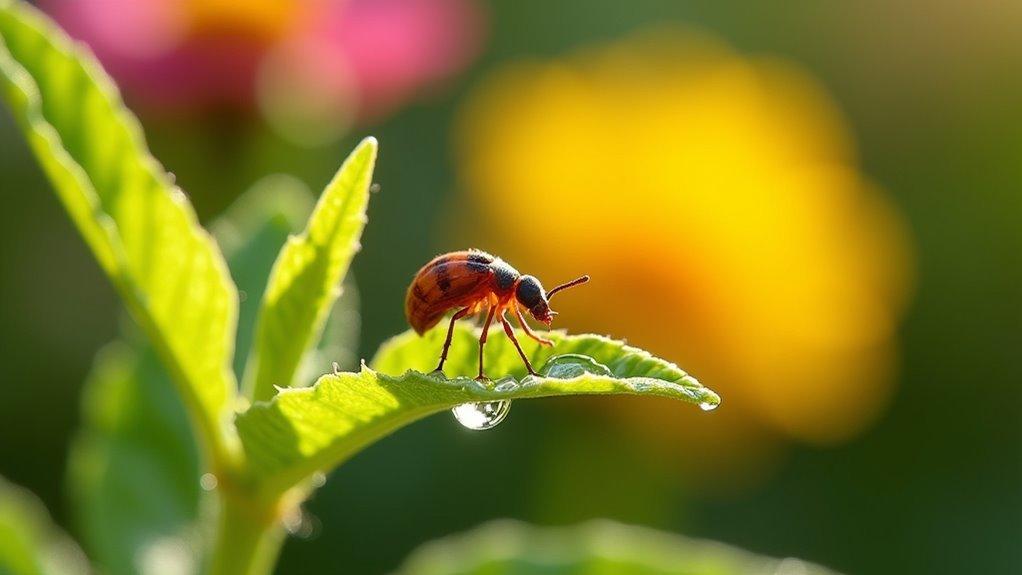
When you apply acetic acid to garden pests, you’re fundamentally weaponizing a simple household chemical that penetrates their protective barriers and triggers rapid cellular destruction.
The lethal concentration found in regular vinegar—around 5% acetic acid—works by disrupting the cuticle of plant leaves and pest exoskeletons. This penetration causes immediate desiccation as the acid draws moisture from cellular structures, leading to dehydration and death within 24 hours.
Agricultural-grade vinegar containing up to 50% acetic acid amplifies this destructive process dramatically.
You’ll observe how higher concentrations accelerate mortality rates, particularly against soft-bodied insects. The acid basically hijacks the pest’s physiological processes, creating an environment where cellular function becomes impossible.
This scientific mechanism makes acetic acid remarkably effective for immediate pest elimination.
How Vinegar Penetrates Insect Exoskeletons
Because acetic acid molecules are exceptionally small and highly reactive, they’ll slice through an insect’s protective exoskeleton like a chemical knife through armor.
You’ll witness how vinegar’s acidic nature breaks down the lipid barriers that normally shield bugs from environmental threats. When you apply vinegar, acetic acid penetrates insect exoskeletons by disrupting their waxy protective coating, creating entry points for moisture loss.
This penetration triggers rapid dehydration as the acid draws water from the insect’s body tissues. You’ll find that soft-bodied pests like aphids succumb almost instantly when exposed.
Higher concentrations above 10% accelerate this deadly process considerably. The acid literally dissolves the structural integrity of the exoskeleton, leaving insects defenseless against desiccation and environmental stress.
Rapid Dehydration Mechanisms in Garden Pests
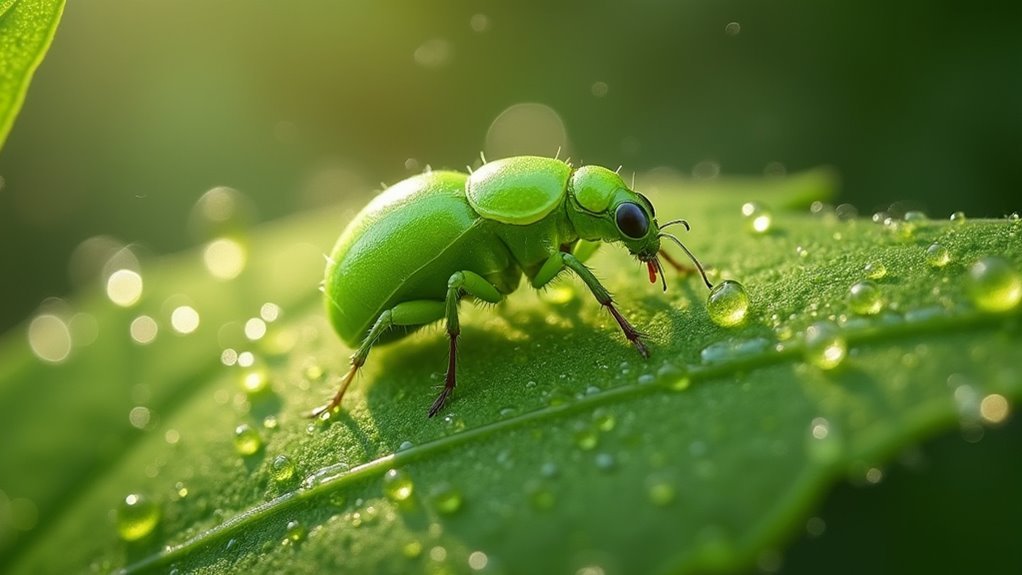
When acetic acid contacts your garden pests, it immediately disrupts their cellular membranes and increases permeability, causing rapid water loss from their tissues.
You’ll notice that insects can lose significant moisture within minutes of exposure, as the acid’s high concentration accelerates dehydration throughout their bodies.
This process creates a timeline of tissue destruction that leads to quick pest mortality when you’re using solutions with adequate acetic acid concentrations.
Cellular Membrane Disruption Process
Acetic acid attacks garden pests at the cellular level, penetrating their protective cuticles and wreaking havoc on delicate internal structures. When you apply this solution, it immediately compromises the cellular membranes that hold pest cells together.
The acid’s corrosive properties break down these crucial barriers, causing them to lose their selective permeability. As cellular membranes collapse, you’ll witness rapid dehydration as water rushes out of the compromised cells.
This process creates severe osmotic imbalance within the pest’s body, accelerating tissue breakdown. The high acidity simultaneously denatures essential proteins, further destabilizing cellular integrity.
Studies show concentrations of 20% or higher achieve a 90% kill rate within hours, making this mechanism devastatingly effective against soft-bodied insects like aphids and spider mites.
Water Loss Acceleration
This membrane breakdown triggers an aggressive dehydration cascade that strips moisture from pest bodies at an alarming rate.
When acetic acid penetrates your garden pests’ protective cuticle, it creates multiple pathways for water loss that rapidly overwhelm their natural regulatory systems. The cellular damage from disrupted pH balance accelerates this dehydration process by making cell walls increasingly permeable to fluids.
You’ll observe this water loss mechanism working fastest on soft-bodied insects like aphids and spider mites, where even 5% acetic acid concentrations trigger severe moisture depletion within hours.
The pest’s inability to retain essential fluids creates a cascading failure throughout their system. This rapid dehydration ultimately proves fatal, making acetic acid an extremely effective organic pest control solution for your garden.
Tissue Destruction Timeline
Within thirty minutes of acetic acid contact, you’ll witness the beginning stages of irreversible tissue destruction in garden pests. The rapid dehydration process accelerates dramatically as acetic acid penetrates their protective cuticle, immediately disrupting cellular membranes throughout their bodies.
You’ll notice soft-bodied insects like aphids and caterpillars becoming visibly shriveled within the first hour. Their cellular collapse occurs systematically as water loss intensifies, causing tissues to contract and harden. Higher concentrations of 20% or more accelerate this timeline considerably.
Young and immature pests succumb fastest, often showing complete tissue breakdown within twelve hours. Most affected insects won’t survive beyond twenty-four hours due to extensive cellular damage and complete dehydration of their crucial organs.
Cellular Disruption and Insect Mortality
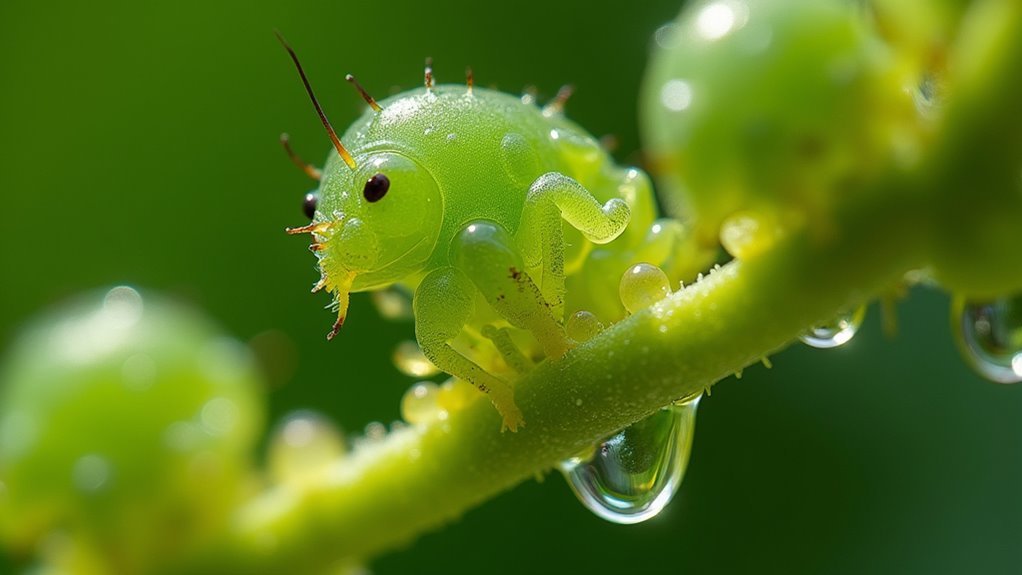
When insects encounter acetic acid, their cellular defenses crumble under the assault of this potent compound. The acid wreaks havoc on cell membranes, causing immediate structural breakdown that leads to catastrophic fluid loss. Your garden pests can’t survive this cellular chaos.
| Exposure Time | Cellular Damage | Death Rate |
|---|---|---|
| 30 minutes | Membrane weakening | 25% |
| 2 hours | Severe dehydration | 75% |
| 6 hours | Complete breakdown | 95% |
| 12 hours | Total destruction | 100% |
The high acidity denatures crucial proteins and enzymes, shutting down essential metabolic processes. Soft-bodied insects like aphids experience rapid insect mortality as their exoskeletons fail. Within hours, dehydration becomes irreversible, making acetic acid devastatingly effective against vulnerable pest populations in your garden.
Why Soft-Bodied Insects Are Most Vulnerable
Unlike hard-shelled beetles or thick-skinned caterpillars, soft-bodied insects possess minimal defensive barriers against acetic acid’s corrosive effects.
You’ll find that aphids, spider mites, and whiteflies fall victim quickly because their thin exoskeletons can’t withstand the acid’s penetration. When acetic acid contacts these pests, it breaks down their protective cuticle, disrupting cellular structure and causing rapid tissue damage.
The vulnerability of soft-bodied insects stems from their inability to maintain proper hydration once their barriers are compromised.
You’ll see dehydration occur within hours as the acid destroys their moisture-retention capabilities. This makes them ideal targets for organic pest control methods.
Research confirms that vinegar solutions eliminate significant percentages of these populations quickly, explaining why gardeners prioritize soft-bodied insects when using acetic acid treatments.
Optimal Concentration Levels for Pest Control
Since household vinegar contains only 5% acetic acid, you’ll need stronger concentrations to achieve effective pest elimination in your garden. For rapid destruction of garden pests, you should target acetic acid concentrations between 20% to 30%, which provide a quick kill rate within 24 hours.
| Concentration | Kill Rate | Target Pests |
|---|---|---|
| 5% (household vinegar) | Low | Limited effectiveness |
| 20-30% | 90%+ | Small, young pests |
| 30-50% | 95%+ | Broader pest range |
Higher concentrations penetrate pest cuticles more effectively, causing rapid dehydration and desiccation of soft-bodied insects. Commercial herbicides containing these stronger acetic acid concentrations deliver superior pest control results compared to standard household vinegar applications.
Environmental Factors That Enhance Effectiveness
You’ll maximize acetic acid’s pest control power by understanding how environmental conditions affect its performance.
Temperature and timing play essential roles in determining how quickly the herbicide works on target plants.
Weather patterns and plant vulnerability windows can make the difference between a successful treatment and wasted effort.
Optimal Temperature and Timing
When you’re planning to apply acetic acid as a garden herbicide, environmental conditions can make or break your treatment’s success. The ideal temperature range of 70°F to 85°F creates perfect conditions for acetic acid application, enhancing its desiccating power against weeds.
You’ll want to time your treatment carefully to maximize effectiveness.
Choose the right moment by considering these key factors:
- Sunny, warm days – Heat amplifies the herbicide’s tissue-damaging action
- Dry conditions – Avoid treating after rain or irrigation to prevent dilution
- Calm weather – Wind causes drift that damages desirable plants
- Early morning or late afternoon – Reduces evaporation loss while ensuring better leaf adherence
Weather Conditions Impact
While temperature sets the foundation for successful acetic acid treatments, broader weather patterns determine whether your herbicide application achieves peak impact.
Dry weather conditions create the perfect environment for vinegar to work effectively, as moisture on leaves dilutes acetic acid concentration and reduces its herbicidal power.
You’ll achieve ideal results during drought periods when stressed plants become more vulnerable to damage. The combination of low humidity and minimal leaf moisture allows acetic acid to penetrate plant cuticles more efficiently, accelerating desiccation.
Choose windless days for application to prevent drift that could harm desirable plants while ensuring peak concentration reaches target weeds.
High humidity works against you, creating excess moisture that impedes the vinegar’s ability to cause rapid plant tissue destruction.
Target Plant Vulnerability
Beyond environmental conditions, certain plant characteristics make weeds particularly vulnerable to acetic acid damage.
Young weeds with minimal leaf development become prime targets since they haven’t developed robust protective barriers against herbicidal stress.
Your application effectiveness depends heavily on targeting the right growth stage:
- Seedlings with one to two leaves – These tender plants absorb acetic acid rapidly through thin cuticles
- Fresh green shoots – New growth lacks waxy protective coating, making penetration easier
- Soft-stemmed annuals – Delicate tissue structure accelerates desiccation process
- Recently germinated weeds – Immature root systems can’t compensate for sudden moisture loss
You’ll notice visible wilting within hours when targeting these vulnerable plants.
Established weeds with thick, waxy leaves often recover because their mature defenses resist acetic acid penetration.
Speed of Action Compared to Chemical Pesticides
Since acetic acid penetrates leaf cuticles rapidly, you’ll see results from vinegar applications much faster than most chemical pesticides.
While traditional chemical pesticides often take several days to show their effects, vinegar delivers visible pest control within 24 hours. This contact insecticide works by disrupting cellular structures in soft-bodied insects like aphids and spider mites, causing quick desiccation and death within hours.
At concentrations of 20% or higher, acetic acid achieves over 90% kill rates on target pests in a remarkably short timeframe.
The rapid breakdown of acetic acid in the environment also means you can re-enter treated areas sooner than with many synthetic alternatives, reducing downtime while maintaining effective pest control.
Target Pests Most Susceptible to Acetic Acid
You’ll find that acetic acid works exceptionally well against soft-bodied pests like aphids, spider mites, and whiteflies since their delicate exoskeletons can’t protect them from the acid’s penetrating effects.
Young and immature pests are particularly vulnerable to treatment, making early detection and prompt application essential for maximum control.
While you’re targeting these susceptible pests, remember that acetic acid doesn’t discriminate and can harm beneficial insects if you’re not careful with your application.
Young Broadleaf Weeds
Among the various garden pests that acetic acid can tackle, young broadleaf weeds stand out as the most vulnerable targets for this natural herbicide.
You’ll find that tender weeds like lambs-quarters and smooth pigweed become prime candidates for vinegar applications within their first two weeks of emergence.
Acetic acid’s ability to kill weeds relies on rapid desiccation through leaf tissue burning.
You’ll achieve excellent results when you apply 5% or 10% concentrations under specific conditions:
- Target weeds with soft, tender foliage that allows easy penetration
- Apply during warm, sunny days to enhance the desiccation process
- Focus on specimens within two weeks of emergence for maximum effectiveness
- Expect visible wilting and death within 24 hours of proper application
Soft-Tissued Annual Plants
While established perennials can resist acetic acid treatments, soft-tissued annual plants represent the ideal targets for vinegar-based pest control.
You’ll find these delicate weeds highly vulnerable because acetic acid penetrates their thin cuticles effortlessly, causing rapid destruction of plant tissue through desiccation.
You’ll achieve best results targeting young annuals with only one or two leaves, as they’re most susceptible to damage.
For effective control, you’ll need concentrations above 5%, though 20% solutions work faster.
Apply treatments on warm, sunny days to enhance absorption and accelerate tissue breakdown.
You’ll see visible results within 24 hours, making acetic acid perfect for quick weed management.
The rapid action guarantees soft-tissued annual plants won’t recover from treatment.
Application Methods for Maximum Impact
When you’re ready to deploy acetic acid against garden pests, timing and technique make all the difference between success and disappointment.
Choose warm, sunny mornings for maximum herbicidal effectiveness, as sunlight amplifies the desiccating power. Target young, vulnerable weeds when they’re most susceptible to contact herbicides.
Your application strategy should include:
- Fill your garden sprayer with household vinegar containing 5-20% acetic acid for peak pest destruction
- Add Castile soap surfactant to create superior leaf adherence and coverage
- Apply on calm, windless days to prevent drift onto desirable plants
- Focus on complete leaf coverage using appropriate application volumes for thorough contact
Avoid windy conditions that compromise accuracy and waste your efforts.
Direct contact with pest foliage ensures rapid cellular damage and quick results.
Safety Considerations When Using High-Concentration Vinegar
High-concentration vinegar solutions above 11% acetic acid pack serious punch against garden pests, but they also pose significant risks to your health and safety.
While high-concentration vinegar effectively controls garden pests, concentrations above 11% acetic acid require serious safety precautions to prevent injury.
You’ll need protective goggles and gloves to prevent severe skin burns and permanent eye damage. Always work in well-ventilated areas since vapors irritate mucous membranes.
Review safety data sheets before handling these products to understand proper procedures and emergency measures.
Remember that vinegar’s non-selective nature means it’ll damage desirable plants alongside pests, so apply carefully.
Since EPA regulations classify high-concentration acetic acid solutions as pesticides, you must follow strict labeling and handling requirements.
Don’t underestimate these powerful formulations – proper preparation and protective equipment aren’t optional.
Limitations and Resistant Pest Species
Although acetic acid delivers impressive results against soft-bodied pests, it won’t work equally well on all garden invaders.
You’ll find that resistant species with tougher exoskeletons, like adult beetles and caterpillars, can withstand acetic acid’s desiccating effects much better than aphids or spider mites.
Pest maturity greatly impacts treatment success.
You’ll notice younger, less developed insects succumb more readily than their mature counterparts.
Consider these challenging scenarios:
- Adult Colorado potato beetles shrugging off direct vinegar applications
- Thick-skinned caterpillars continuing to munch after treatment
- Beneficial ladybugs suffering unintended harm alongside target pests
- Persistent infestations returning quickly without residual protection
You’ll need repeated applications for stubborn problems, and acetic acid’s non-selective nature means you risk damaging helpful insects that naturally control garden pests.
Cost-Effectiveness of Vinegar-Based Solutions
You’ll find that vinegar-based pest control comes with a significant price tag, costing $360 to $2400 per mile compared to glyphosate’s modest $20 per mile.
While the initial sticker shock might make you reconsider, you’re also looking at repeated applications for stubborn pests, which can quickly multiply your expenses over time.
Your budget will need to account for these ongoing treatments, especially when dealing with larger or perennial pest problems that don’t surrender after the first round.
Price Per Application
When considering vinegar-based pest control solutions, you’ll face a significant cost disparity compared to conventional alternatives. The price per application varies dramatically depending on your chosen acetic acid concentration and coverage area.
Your vinegar options present different economic realities:
- Household vinegar (5% acetic acid) costs less upfront but demands multiple treatments.
- Commercial-grade solutions (20%+ concentration) deliver faster results at premium prices.
- Large-scale applications can cost $360-$2400 per mile versus $20 for glyphosate.
- Repeated treatments become necessary due to vinegar’s lack of residual activity.
You’ll find organic herbicides particularly cost-effective for small gardens and spot treatments.
However, you must weigh the higher per-application costs against your pest control goals and budget constraints when tackling larger infestations.
Glyphosate Cost Comparison
These cost considerations become even more stark when comparing vinegar directly to glyphosate treatments.
You’ll pay approximately $20 per mile for glyphosate weed control, while vinegar-based solutions range from $360 to $2400 per mile.
That’s a massive difference for large-scale applications.
Acetic acid herbicides typically cost over three times more per square foot than glyphosate, making the economic gap undeniable.
Higher vinegar concentrations like 20% may provide better results but amplify costs considerably.
Since vinegar lacks residual activity, you’ll need multiple applications throughout the season, while glyphosate’s longer-lasting effects reduce retreatment frequency.
For persistent weeds, your repeated vinegar treatments could exceed glyphosate’s initial investment, making this herbicide comparison financially challenging.
Long-Term Treatment Expenses
Although vinegar offers an organic approach to weed management, its long-term financial impact requires careful consideration beyond the initial sticker shock.
You’ll face mounting long-term expenses with acetic acid solutions due to their lack of residual activity. Unlike synthetic herbicides that provide extended protection, vinegar requires frequent reapplications to maintain effective weed control.
Your ongoing treatment costs include:
- Multiple seasonal applications – persistent weeds bounce back quickly without residual protection
- Higher concentration formulas – requiring specialized safety equipment and training
- Precision spot treatments – demanding constant monitoring to avoid damaging desirable plants
- Replacement materials – frequent purchases throughout the growing season
These repeated applications can quickly escalate your annual maintenance budget, making vinegar’s true cost considerably higher than initial comparisons suggest for thorough weed management programs.
Long-Term Benefits for Organic Garden Management
Since acetic acid naturally breaks down in soil without leaving harmful residues, you’ll build a sustainable pest management system that protects your garden’s long-term health.
This organic gardening approach eliminates synthetic pesticide dependency while maintaining effective pest control. You’ll create a balanced ecosystem where beneficial insects thrive alongside your crops, as selective application targets only harmful pests.
Your garden becomes more resilient over time, developing natural defenses against pest infestations. The absence of chemical residues means you’re producing safer food for your family while supporting soil health.
Regular vinegar treatments establish consistent pest deterrence without disrupting the garden’s natural balance. This sustainable gardening method reduces long-term costs while promoting environmental stewardship, making your organic garden both productive and ecologically responsible.
Frequently Asked Questions
What Does Acetic Acid Do to Soil?
You’ll find acetic acid temporarily lowers soil pH, disrupts beneficial microorganisms, and breaks down quickly. It can damage plant tissues at high concentrations but isn’t effective for long-term soil management due to requiring large volumes.
Does Vinegar Work Better Than Roundup?
You’ll find vinegar works faster on young weeds but isn’t as effective as Roundup overall. Household vinegar’s too weak for established plants, while Roundup provides longer-lasting control on tougher weeds.
What Happens When You Use Vinegar in Your Garden?
You’ll see rapid damage to weeds and pests within 24 hours as vinegar burns their foliage. However, you risk harming desirable plants and may need repeated applications for perennial weeds.
What Percentage of Acetic Acid Kills Weeds?
You’ll need 5-10% acetic acid for young weeds, but 20% or higher works best with 90% kill rates. For mature weeds, you’ll want 30-50% concentrations, though they’re more dangerous to handle.
In Summary
You’ve discovered that acetic acid’s rapid action against garden pests isn’t magic—it’s science. When you apply vinegar, you’re disrupting cellular membranes and triggering instant dehydration in soft-bodied insects. While it won’t eliminate every pest species, you’ll find it’s a cost-effective, organic solution that delivers immediate results. Remember to use proper concentrations and protective gear. By incorporating acetic acid into your pest management strategy, you’re choosing an environmentally responsible approach that protects your garden naturally.


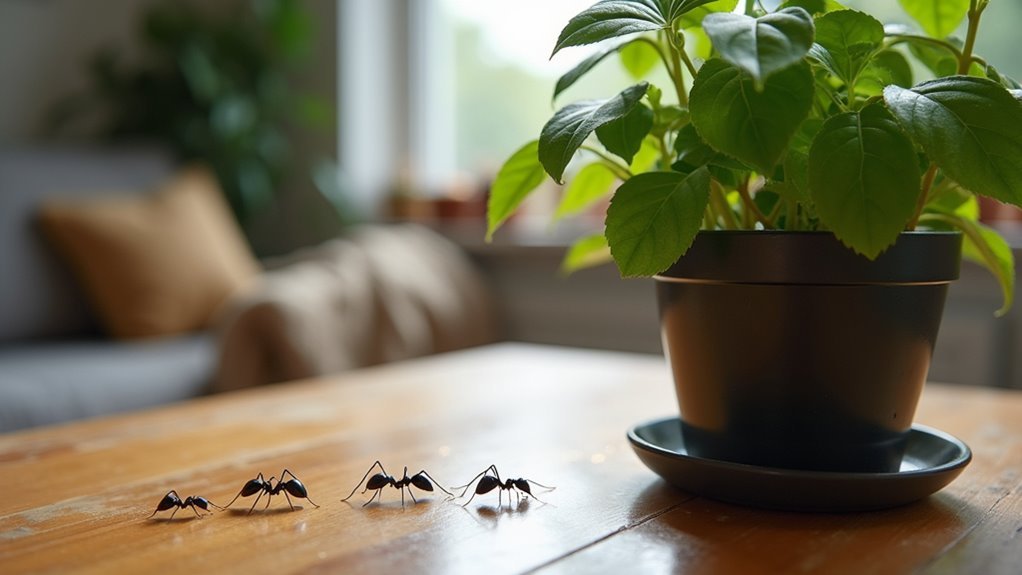
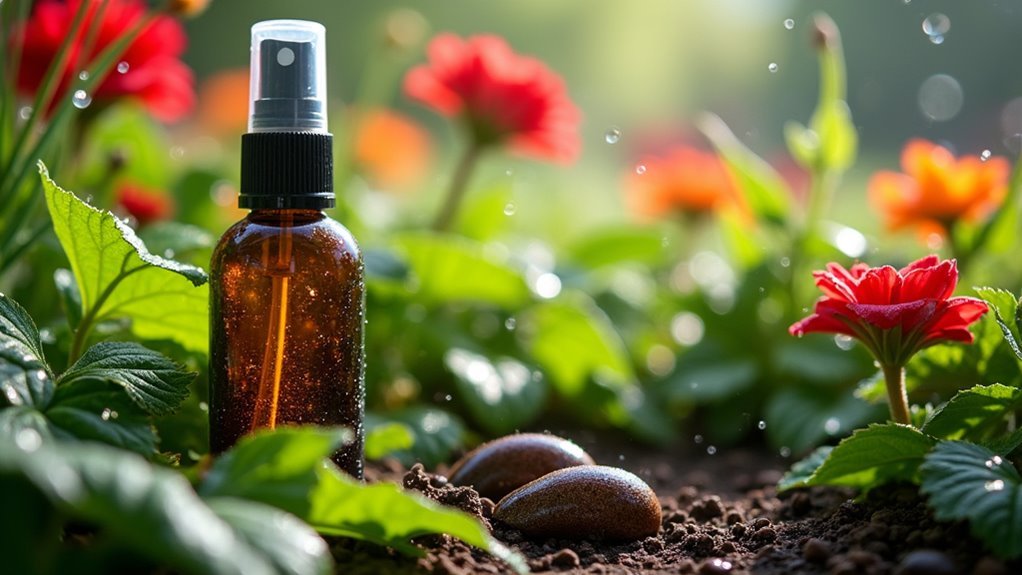
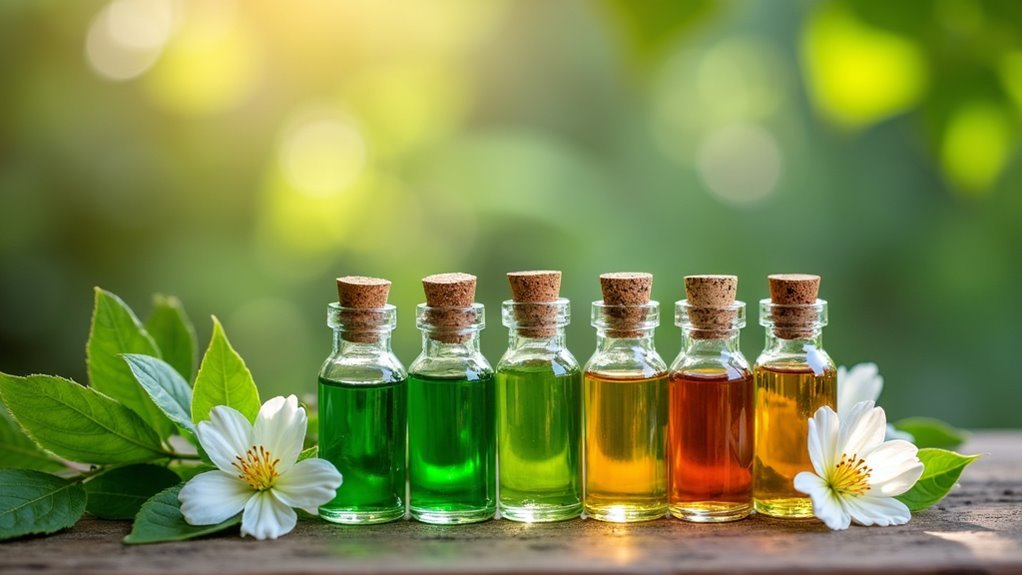
Leave a Reply